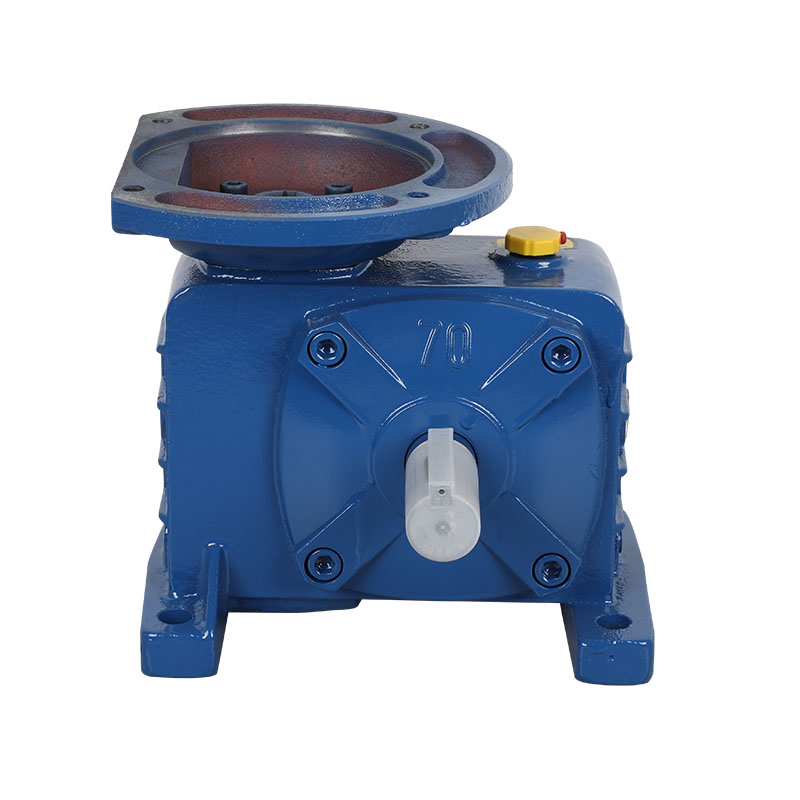The impact resistance of WP Single Stage Worm Gear Reducer is one of its important characteristics in practical applications, but its performance depends on the specific design, material selection and operating conditions. The following analyzes its impact resistance in detail from the aspects of working principle, structural characteristics, material properties and application scenarios:
The basic principle of impact resistance
How to mesh the worm and the worm gear
The WP single-stage worm gear reducer reduces speed through the meshing of the worm and the worm gear. Due to the large contact area between the worm and the worm gear, this design can disperse the impact load to a certain extent, thereby improving impact resistance.
However, due to the low transmission efficiency of the worm gear reducer (usually 50%-90%), its impact resistance is slightly insufficient compared to gear reducers or planetary reducers.
The impact of self-locking characteristics
The worm gear reducer has a certain self-locking function (especially in the case of large transmission ratios), which can reduce the impact of shock caused by sudden load changes in some scenarios. However, this self-locking characteristic may also limit its dynamic response capability, thereby showing certain limitations in high impact conditions.
The impact of material on impact performance
Worm material
Steel worm:
Steel worms (such as alloy steel or carbon steel) have high hardness and wear resistance after hardening, and can withstand large impact loads.
In high impact scenarios, steel worms perform better than ordinary materials.
Stainless steel worm:
Stainless steel is not only corrosion-resistant, but also has good toughness, which is suitable for dealing with shocks in humid or corrosive environments.
Worm gear material
Bronze Worm Gear:
Bronze (such as tin bronze or aluminum bronze) is a commonly used material for worm gears, with good wear resistance and impact resistance, especially in low speed and high torque application scenarios.
The flexibility of bronze allows it to absorb part of the impact energy and reduce damage to the worm.
Aluminum alloy worm gear:
Aluminum alloys are lighter but have poor impact resistance and are usually used in scenarios with low load or lightweight design.
The impact of design on impact resistance

Tooth surface machining accuracy
High-precision tooth surface processing can reduce friction and impact during meshing, thereby improving impact resistance. For example:
Precision-grinding worm and worm gear has a higher surface finish, which reduces vibration and noise during operation.
A reasonable meshing clearance design can avoid jamming or damage caused by impact.
Housing strength
The material and thickness of the reducer shell directly affect its impact resistance:
Cast iron shell: has high strength and rigidity, and can effectively resist external impacts.
Aluminum alloy shell: lightweight but low strength, suitable for low impact scenarios.
Lubrication system
Lubricating oil not only reduces friction, but also absorbs impact energy to a certain extent. High-quality lubricating oil and reasonable lubrication system design can significantly improve the impact resistance of the reducer.
Impact resistance in practical application scenarios
Industrial Equipment
In conveying systems (such as belt conveyors or chain conveyors), WP single-stage worm gear reducers are usually able to withstand moderate impact loads, especially when starting or stopping.
If the impact load is too high (such as heavy load start or frequent start-stop), additional buffering devices (such as hydraulic couplers) may be required to protect the reducer.
Agricultural machinery
In agricultural machinery (such as mixers or feed crushers), WP single-stage worm gear reducer needs to deal with the impact of material blockage or sudden load changes. High-strength materials and optimized design reducers can meet these needs.
Automation equipment
In automation equipment, WP single-stage worm gear reducer usually operates under stable operating conditions and has a small impact load, so its impact resistance is good.
Methods to improve impact resistance
Optimize material selection
Select the appropriate material combination according to the specific working conditions. For example:
High impact scenario: Choose high-strength steel worm and tin bronze worm gear.
Lightweight scenario: Choose an aluminum alloy shell and an aluminum alloy worm gear.
Improved design
Increase the modulus of the worm and worm gear (i.e. tooth pitch) to improve load-bearing capacity and impact resistance.
Add buffering devices (such as springs or shock pads) inside the reducer to further absorb impact energy.
Strengthen lubrication
Use high viscosity lubricating oil or add impact-resistant additives to reduce damage to the tooth surface by impact.
Regularly check the status of the lubricant oil to ensure the normal operation of the lubricating system.
Install the buffer device
Install buffer devices (such as elastic couplings or hydraulic couplers) at the input or output to reduce the impact of impact on the reducer.
In practical applications, the appropriate reducer model and configuration must be selected according to the specific working conditions to ensure its reliability and stability in long-term operation.

 English
English русский
русский bahasa Indonesia
bahasa Indonesia
